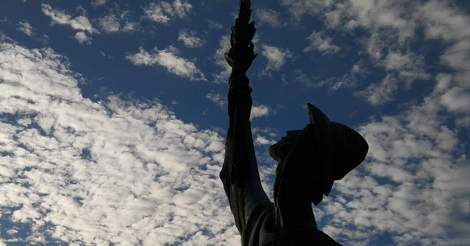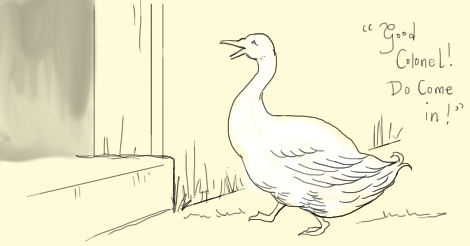The 1800s were a strange time in American History. The country was still newly formed, and there had been enough generations of white people that it had its own culture. Most people were stuck on their little farms that were somehow one thousand acres big, but a whole lot of people were adventurers or essentially hobos. Good ol’ hobos.
Pioneers! Families set off in caravans and covered wagons into the wild west, which at the time reached as far as Indiana. There were many real characters among them, mostly rugged individualists and evangelists, as far as I know. And people were excited to see them and hear from them because they didn’t have television or radio. They barely even had newspapers!
Like Johnny Appleseed, they were real people who walked around and became legendary. Yes, Johnny Appleseed was a real man, not just a quaint Disney cartoon character that turned out to be American FAKElore, like Paul Bunyan and Pecos Bill. He did some planting ’round these here parts, so I happened to learn a little bit about him and his hobo apple man lifestyle as a result. Oh he was kind and loved conservation back in those early 1800s, but he was also a Swedenborgian missionary nut, going around preaching or whatever. But people seemed to like him, and that’s good enough for me.

Fakelore though, that’s an exciting concept to me. Paul Bunyan! Pecos Bill! They were in cartoons and I thought they were based on real people! I was tricked! And if I was that means EVERYONE was. It’s a low down dirty trick you played on us, early 1900s advertisers and short story writers! To invent characters but then claim that other people have been talking about them as real folklore for centuries? Who does that kind of thing? Tsk.
Well that aside, as a fledgling folklorist who has been gathering lost legends for at least the past three days, I am here to educate you on some lesser known characters who really did exist in centuries gone by. They must have been real figures who really lived and died, because how could it be anything but true? Read on.
Andy Peachpit
Andy was very similar to Johnny Appleseed, only set in Maine. He went around planting peach tree orchards. However, he was a bitter man known for complaining. This was because Appleseed was much more popular and also much more successful. Peachpit never apprenticed under an orchardist and never learned much about tree nurseries. Few of the peach trees survived because he refused to believe in Hardiness Zones for planting.
Davy Thunderstick
Firearms had existed for hundreds of years at this point, and the west was won in large part due to their existence. But that didn’t stop ol’ Davy Thunderstick from going from settlement to settlement, trying to sell actual sticks coated in gunpowder to children. Adults tolerated this because he gave freely of his unique brew of fermented mash, which was known as “fiery thundersticks.”

Rhonda Roundworm
Most women of the time were restricted to homemaker roles, and if they set out on their own, were spiritualists, advocates of temperance, or affiliated with the brothel trade. By all reports, Rhonda was driven from town to town because outbreaks of the skin condition called “roundworm” were attributed to her. It surely wasn’t the worst ailment afflicting people of the time, but it even then, people were grossed out by it.
Colonel Featherbottom
Many legends had animal sidekicks, but in this case, a stately grey goose was treated as a dignified figure, and he had a wacky elderly and frequently intoxicated human sidekick known as Dr. McGander, an Irishman. The goose would be invited into homes and praised while Dr McGander had to wait outside. A few towns in southern Pennsylvania accepted Colonel Featherbottom as their elected mayor.

Molly Watermelon
American folklorists believe that Molly Watermelon may have been a frequently pregnant woman living in disgrace during the late 1700s and into the early 1800s. Something of a rambler, she lived a kind of double life. She didn’t stay in place for very long, and after birthing and leaving the infant on a stoop, would simply have a bath, steal new clothes, and go by another name. This trickery caused her Watermelon form to be thought of as a sign of fertile harvests, good omens, and of one baby being found, eventually.
Jimmy Applecore
Riding on the wave of popularity regarding Johnny Appleseed, Jimmy Applecore had all of the eccentricities with none of the knowledge of planting apple orchards. Instead, he ate apples he “found” growing under the veil of night and “planted” the seeds basically by leaving a trail of apple cores behind him. Regarded as a thief and litterer, he was not well-received most places he went.